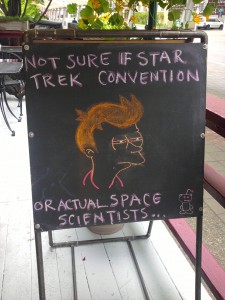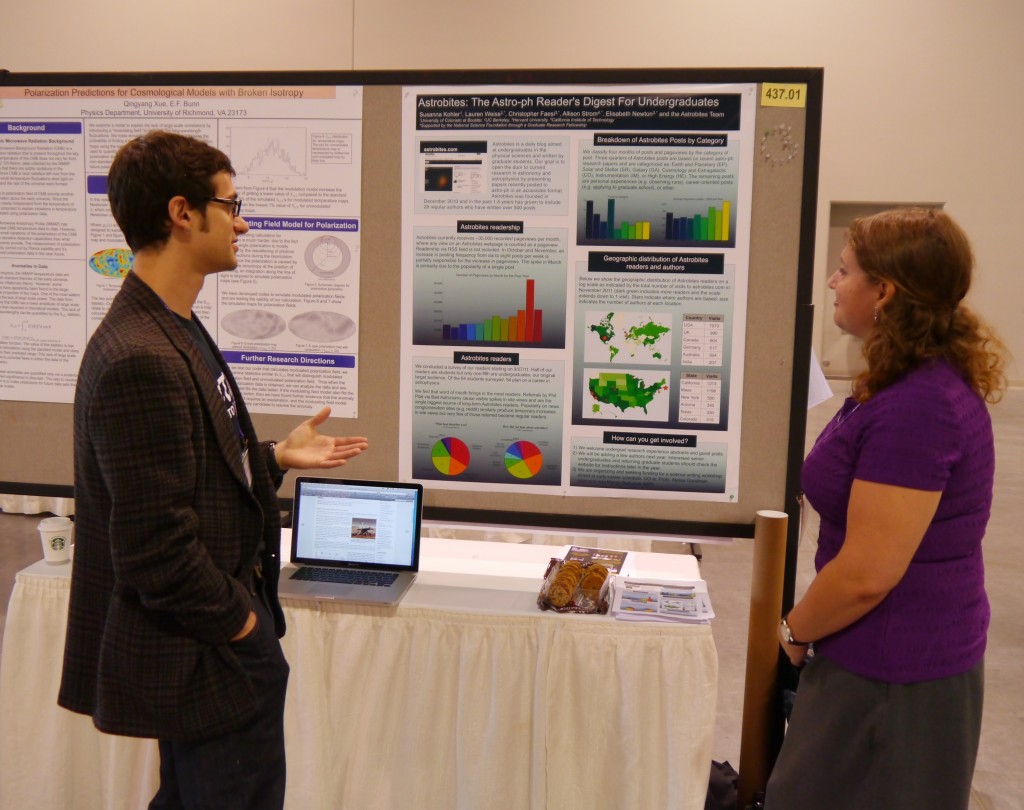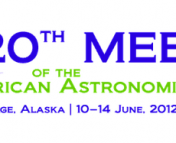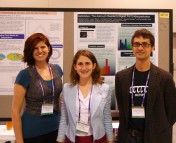
More support from the local coffee shop. (My answer: characterizing the habitability of planets happens at both.)
Astrobites is again liveblogging AAS! In order to avoid inundating our readers’ RSS feeds, we’ll be updating this post with short paragraphs about the talks we’ve heard and posters we’ve seen. So keep checking back throughout Wednesday afternoon!
3:40pm – Under the Radar: The First Woman in Radio Astronomy, Ruby Payne-Scott (W. Miller Goss, NRAO)
Dr. Goss gave an interesting overview of the life and accomplishments of one of the first radio astronomers, Ruby Payne-Scott. Ruby was born in 1912 and was one of the first women in Australia to receive a bachelor’s degree in physics. She was able to break into the job market when World War II started, and worked as a radio engineer and on radar development from 1939-1945. She was an expert on the detection of aircraft using Plan Position Indicator Displays. Ruby began her very short career as a radio astronomer in 1945 when she was put in charge of a group studying solar noise. Though she was only a radio astronomer for 6 years, she was immensely successful in that time: she was part of the first use of radio astronomical interferometry (in Jan 1946, observing one of the largest sunspots in recorded history), and she is credited with the discovery of Type I and Type III radio bursts. A pioneer in the field of radio astronomy, Ruby also faced significant challenges due to her gender: she was forced to keep her marriage a secret for years because married women weren’t allowed to hold permanent positions. She retired in 1951 due to the birth of her son — there was, of course, no maternity leave at the time.
1:00 pm – Beyond Kepler: Opportunities for Characterization of Exoplanet Atmospheres in the Next Decade
A panel of scientists weighed the wealth of knowledge we can obtain from studying the atmospheres of planets against the difficulty of measuring the properties of those atmospheres. Studying the atmospheres of planets can teach us about their temperature profiles, chemical abundances, and – ultimately – habitability. Before delving into the discussion on atmospheres, Natalie Batalha (San Jose State University) expressed her fear that the “treasure trove” of exoplanet candidates Kepler has discovered will “languish” after the mission because many of them orbit stars that are too faint for current follow-up techniques. “We need investment in radial velocity instruments of higher precision so we can get the masses of these small planets,” she says, referring to the method of measuring a planet’s mass (and thus its density, and with modeling, interior composition) based on the gravitational reflex of its host star. In addition, Natalie acknowledges that the earth-size planets, although the most abundant, are the least promising targets for atmospheric characterization. This is because planets like Earth and Venus, which are dense and rocky, have very thin, low atmospheres. The technique of transmission spectroscopy (see these astrobites for examples) characterizes a planetary atmosphere from starlight that shines through that atmosphere; a thin atmosphere leaves a smaller spectral fingerprint than a thick one. Mark Swain (Jet Propulsion Laboratory) noted that the only earth-size planets with characterize-able atmospheres are those orbiting the smallest stars: the very faint spectral type M7-M9 dwarfs. Nonetheless, he is optimistic that the proposed Explorer-class mission FINESSE, which, if launched, will take a continuous spectrum from 1-5 microns (a region of the spectrum rich in molecular features), will explore the atmospheric variety of larger planets around larger stars; he claims a list of 100 planets ready for atmospheric characterization. Meanwhile, Michelle Creech-Eakman (New Mexico Institute of Technology) discussed NESSI, a low-resolution spectrometer her lab built for $2 million that will attempt to characterize exoplanet atmospheres from the ground, and Kevin France (University of Colorado) mentioned that transit spectroscopy in the ultraviolet region of the spectrum can teach us about how much UV radiation, which might be necessary for life but can also kill (think skin cancer on Earth, but worse), exoplanets in the habitable zone absorb in their atmospheres.






Re: Ruby Payne-Scott
…and yet despite the accomplishments of women astronomers, (correct me if I’m wrong) not a single major telescope or observatory has ever been named after a woman!